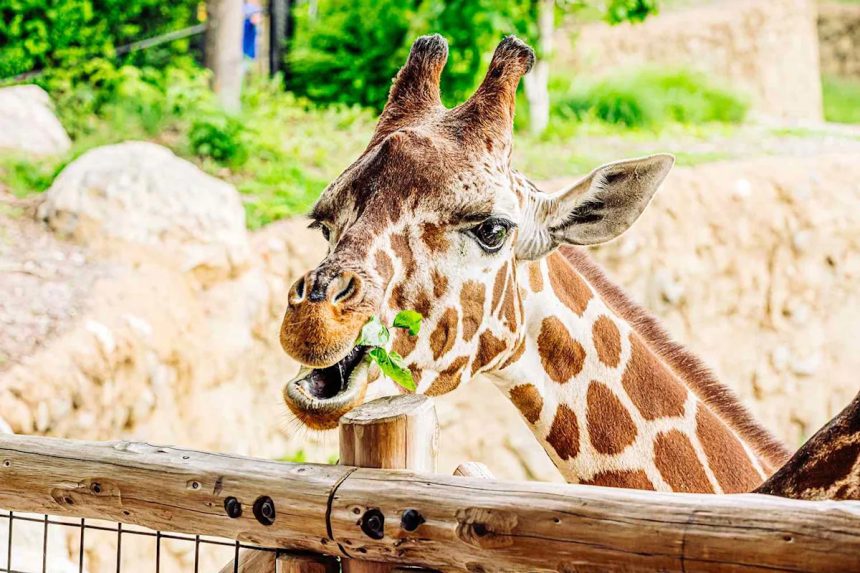NEED TO KNOW
-
Omaha’s Henry Doorly Zoo and The Nature Conservancy are working together to tackle a woody encroachment at Iowa’s Folsom Point Preserve
-
The encroachment, full of invasive trees and shrubs, is negatively impacting the natural grasslands of the preserve and its animals
-
The Henry Doorly Zoo helps The Nature Conservancy cut down the damaging plants, which are then fed to the zoo’s large animals
The animal residents of Omaha’s Henry Doorly Zoo and Aquarium are doing their part to keep the whole planet healthy.
Giraffes, elephants, and other animals at the Nebraska zoo have added invasive tree and shrub species to their diets through a mutually beneficial partnership between Henry Doorly Zoo and The Nature Conservancy.
The partnership was formed to address the invasive trees and shrubs encroaching on the natural grasslands in TNC’s Folsom Point Preserve in Iowa, which is located just over 12 miles from Omaha’s Henry Doorly Zoo. While more plants may seem beneficial, TNC points out that the tree and shrub takeover is damaging to the natural grassland ecosystem present in the preserve.
According to the nonprofit, when trees and shrubs take over grasslands, groundwater and prairie streams get depleted, soil health is compromised, and the bedrock below the grasslands is altered. Additionally, the invading trees and shrubs also compete with prairie plants for light, water, and space, often pushing the grassland plants out of the way and diminishing the habitat options available to animals that depend on native plants.
As a way to help curb these issues without generating waste, TNC teamed up with the Henry Doorly Zoo to cut back the trees and shrubs at the preserve and then use the clippings to supplement the diets of some of the zoo’s largest animals.
© Joshua Foo Photography
A worker clears part of the woody encroachment at Folsom Point Preserve
“The Nature Conservancy and Omaha’s Henry Doorly Zoo and Aquarium have a longstanding relationship, with past zoo leaders serving as volunteer leaders for TNC’s Nebraska Chapter. While we’ve collaborated informally over the years, this marks our first official project together. Our teams saw an opportunity to turn a conservation challenge into a win-win solution for both TNC and the zoo,” Graham McGaffin, TNC’s Iowa State Director, tells PEOPLE.
“At Folsom Point Preserve in Iowa’s Loess Hills, TNC regularly manages invasive trees and shrubs to protect native prairie habitat. Meanwhile, the zoo’s Browse Program seeks safe, nutritious plant materials to feed its animals. By partnering, we’re able to repurpose this vegetation—what would otherwise be waste — into valuable food for the zoo’s animals,” he added.

© Joshua Foo Photography
Elephant eating invasive trees and shrubs removed from The Nature Conservancy’s Folsom Point Preserve
Dr. Cayla Iske, the director of nutrition at Omaha’s Henry Doorly Zoo, says the work with TNC at Folsom Point Preserve sprang up “when the paths of the zoo and The Nature Conservancy crossed at a multi-organizational work day to clear trails, it was a perfect fit.”
Today, the zoo sends workers to the preserve to help clear the encroaching trees and shrubs, which they then transform into “browse” —plant material for animal feeding.
“The zoo gains a high-quality source of browse for its animals, which is vital for their diet and enrichment. The collaboration ensures animals receive fresh, natural foods that encourage their natural behaviors, like foraging, stripping bark, or reaching for leaves. It also strengthens the zoo’s commitment to conservation,” Dr. Iske shares on why the preserve partnership is a win for the zoo.

© Joshua Foo Photography
A giraffe having a snack at Omaha’s Henry Doorly Zoo
According to her, the zoo takes the palatable trees removed from the preserve — dogwood, sumac, elm, mulberry, and boxelder — and feeds them to a variety of zoo animals, including gorillas, elephants, and giraffes.
Never miss a story — sign up for PEOPLE’s free daily newsletter to stay up-to-date on the best of what PEOPLE has to offer, from celebrity news to compelling human interest stories.
“Most of these tree species are palatable to our animals at the zoo, but every animal does have their favorite (and least favorite.) For example, the gorillas don’t prefer mulberries, while it is almost every other animal’s favorite. The elephants, goats, and rhinos like sumac, while most other animals don’t prefer it. Every animal is different, and the browse team works closely with our animal care team members to provide the plants animals like most,” Dr. Iske adds.

© Joshua Foo Photography
Part of the crew that removes invasive plants from TNC’s Folsom Point Preserve, so the clippings can be fed to Henry Doorly Zoo animals
This partnership is one approach to tackling tree and shrub encroachment at the preserve, but TNC says it will take more to tackle this invasive plant issue. The organization is also working with ranchers to establish prescribed burn associations to manage the damaging plants and is organizing community cutting days to reduce woody encroachment further.
“One of the most effective ways people can help is by planting native species in their yards and gardens. Native plants are better adapted to local conditions and provide essential food and habitat for wildlife, while also helping prevent the spread of invasive species,” McGaffin says about how anyone can contribute to helping native animals and plants in need.
Read the original article on People









